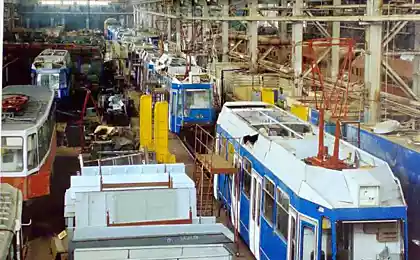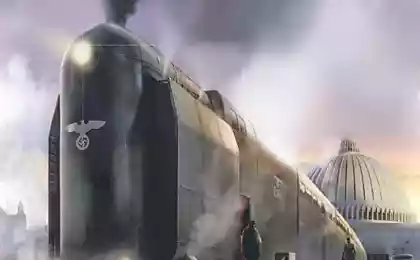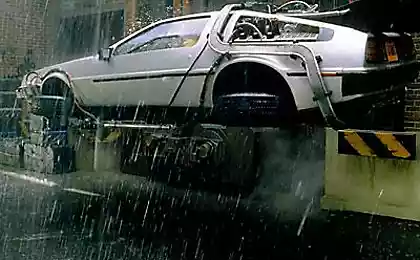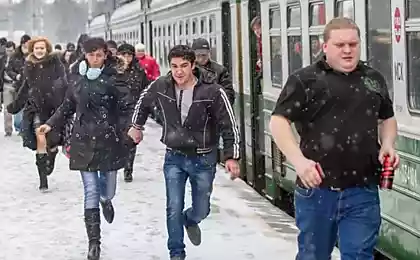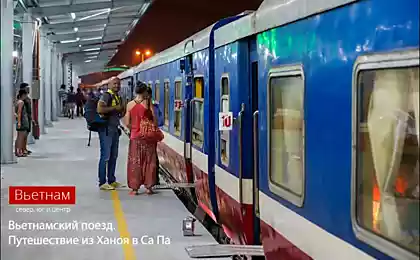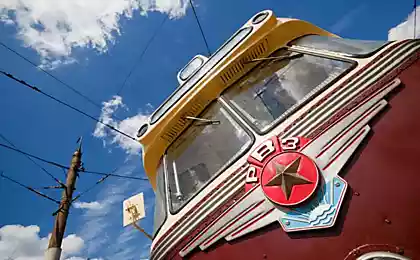3150
"Flying car" Yak-60
During the existence of the Yakovlev Design Bureau, they were created more than 200 different types and modifications of aircraft, among them more than 100 series machines. Aircraft of the KB is in production continuously since 1932, for 70 years, was released more than 70,000 aircraft "Yak", but the planes were not the only product designers. LMC Yakovlev had time to try your hand in the helicopter. The presence of a helicopter in the aviation themes KB someone may seem unusual, but the fact remains. Cargo helicopter Yak-24, created by designers KB, received wide acclaim, and was developed in the era of jet cargo glider race Yak-14 looked quite original. Both of these machines are mass-produced, unlike project cargo helicopter Yak-60, which outshines them with its size.
7 images
Let's find a detailed history of this project ...
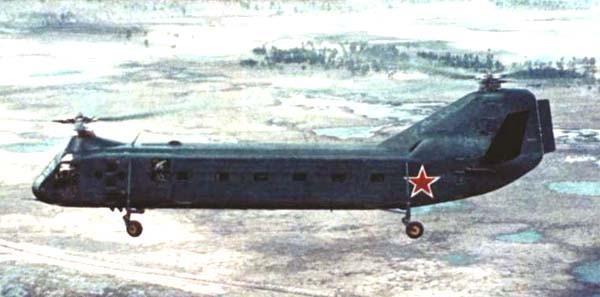
Helicopter Yak-24 was memorable name "Flying car", which is well suited his appearance. This helicopter is equipped with two engines AL-82B capacity of 1430 hp In the period from 1953 to 1957 it was the largest helicopter in the world. The maximum loading capacity is reached 4 tons. That was an excellent indicator for those years. Cargo Glider Yak-14 was also quite successful development. It was designed for the transportation by air of bulky cargo weighing up to 3, 5 ton, for example, he could transport trucks, only 408 were built gliders.

For EDO, which since inception has specialized in the design of aircraft, transport helicopter, the Yak-24 was designed for a relatively short time. From the beginning of the conceptual design (work started in 1951) before the first flight (July 1952) took only 9 months. For example: the design of the helicopter, "Piasecki H-16", which was comparable with the Soviet payloads, began in 1946. In this helicopter first flew in 1953. However, it is the American designer Piasecki helicopters became a catalyst for the creation of a Soviet transport helicopter built using longitudinal scheme.
Constructively in a helicopter of the Yak-24 was applied all carrier system (main gearboxes, blades) and powerplant with the Mi-4. Manufacture of transport helicopter was deployed in April 1955, all were manufactured at least 40 helicopters with a large fuselage. Yakovlev Yak-24 could accommodate a crew of 3 people, and 30 soldiers in full combat gear, or up to 3 tons of cargo. Helicopter, as already mentioned, was built along the longitudinal twin-screw pattern. As the power plant used 2 piston engine AL-82B. In late 1955 this helicopter was the author of two world records associated with a raised load. Thus, the first machine lifted a weight of 4 tons to a height of 2902 meters and then a weight of 2 tons to a height of 5082 meters.

In 1955 and 1956 4 helicopters Yak-24 took part in the famous Tushino aviaparada. In 1959, the helicopters used during military maneuvers in the GDR, as well as in the district of the Ukrainian capital. Yakovlev Yak-24 successfully completed the flight from Moscow - Berlin and Moscow - Kiev. For all the time of its operation has not been a single accident with fatalities.
The success of the Yak-24 helicopter did not go unnoticed. And in the design office reflect on the creation of a project even larger helicopter, performed on the same longitudinal pattern. Thus was born the project of heavy military transport helicopter of the Yak-60, which payloads could compete with many military transport planes.
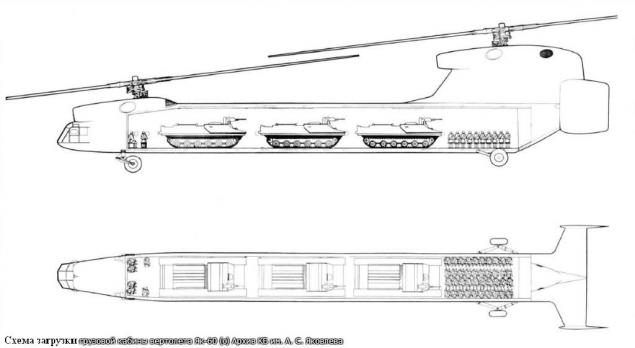
Given the experience of the establishment and operation of the helicopter of the Yak-24, the Leningrad branch of OKB-115, the factory MAP №272 in Leningrad, under the leadership of Igor A. Ehrlich, according to the February 1958 Resolution of the Council of Ministers of the USSR, preparing a project of a new heavy four helicopters, longitudinal scheme - the Yak-60.
This machine is a further development largely successful Yak-24. The new helicopter, designated the Yak-60, was to be the analogue of the lifting of the helicopter in the world, which was designed by Mil, it is a B-12 helicopter. Take-off weight of the Yak-60 was supposed to be about 100 tons. The rotors were borrowed from the Mi-6, each of them revolved two engines D-25VF. According to the project the helicopter could lift weights weighing up to 42 tons, this payload allowed to use a helicopter to transport the tanks on the external load, such as the T-64. However, unlike the helicopter Mil, Yak-60 remained forever design machines that do not climb into the sky. Was produced only a slight amount of layouts of the helicopter.
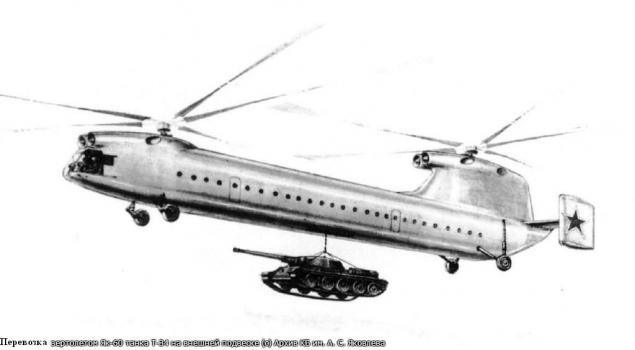
Work on the design of the Yak-60 was engaged in the Leningrad branch of OKB-115 factory MAP №272 under the direct supervision of chief designer Igor A. Ehrlich. When it is taken into account the experience of the design development and operation of its predecessor - the Yak-24. Draft new heavy helicopter longitudinal circuit having 4 engine began to develop on the basis of a Council of Ministers of February 1958. The helicopter had to be used at once 4 powerful gas turbine engine D-25VF developing by 6497 hp each. Dimensions giant helicopter from Yakovlev were as follows: length - 44, 6 m, width - 8, 6 m, height - 11, 6 m.
These dimensions and load capacity of 40 tons before the helicopter opened great opportunities. The purpose of the helicopter giant who excelled "Flying car" Yak-24 was the airlift: tanks, self-propelled guns, armored vehicles, ballistic missiles, land-based radar, bridge trusses, pontoon units, oil rigs, power poles, river ships, ammunition and other weapons, as well as a variety of oversized cargo economic purpose.
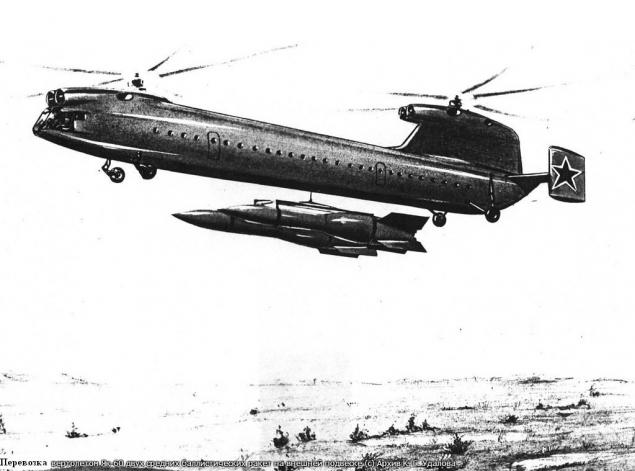
In addition to the spacious cargo cabin, Yak-60 could carry cargo on external sling. The helicopter could take on board up to 228 soldiers, Marines in full combat gear and 176 wounded, accompanied by 8 health workers. However, work on the helicopter never went beyond the project and the technical proposal. The reason was the refusal of the OKB-115 helicopter of subjects, as well as the closure of its branch of the Leningrad with the subsequent reorientation of the plant № 272. However, such a giant in the USSR yet been established. We are talking about the helicopter-12 Mil (sometimes called the Mi-12, although this name change was never performed). At the B-12 were used the same engines D-25VF. It made its first flight in 1968, the car is still the biggest and lifting helicopter in the world.
Internet
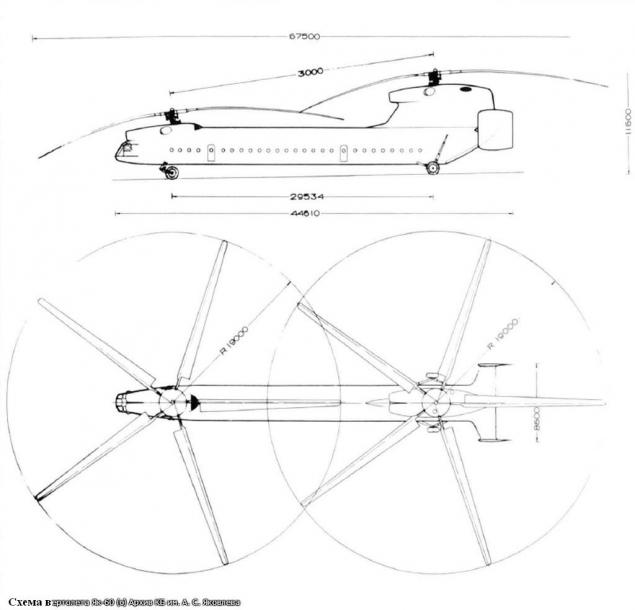
7 images
Let's find a detailed history of this project ...

Helicopter Yak-24 was memorable name "Flying car", which is well suited his appearance. This helicopter is equipped with two engines AL-82B capacity of 1430 hp In the period from 1953 to 1957 it was the largest helicopter in the world. The maximum loading capacity is reached 4 tons. That was an excellent indicator for those years. Cargo Glider Yak-14 was also quite successful development. It was designed for the transportation by air of bulky cargo weighing up to 3, 5 ton, for example, he could transport trucks, only 408 were built gliders.

For EDO, which since inception has specialized in the design of aircraft, transport helicopter, the Yak-24 was designed for a relatively short time. From the beginning of the conceptual design (work started in 1951) before the first flight (July 1952) took only 9 months. For example: the design of the helicopter, "Piasecki H-16", which was comparable with the Soviet payloads, began in 1946. In this helicopter first flew in 1953. However, it is the American designer Piasecki helicopters became a catalyst for the creation of a Soviet transport helicopter built using longitudinal scheme.
Constructively in a helicopter of the Yak-24 was applied all carrier system (main gearboxes, blades) and powerplant with the Mi-4. Manufacture of transport helicopter was deployed in April 1955, all were manufactured at least 40 helicopters with a large fuselage. Yakovlev Yak-24 could accommodate a crew of 3 people, and 30 soldiers in full combat gear, or up to 3 tons of cargo. Helicopter, as already mentioned, was built along the longitudinal twin-screw pattern. As the power plant used 2 piston engine AL-82B. In late 1955 this helicopter was the author of two world records associated with a raised load. Thus, the first machine lifted a weight of 4 tons to a height of 2902 meters and then a weight of 2 tons to a height of 5082 meters.

In 1955 and 1956 4 helicopters Yak-24 took part in the famous Tushino aviaparada. In 1959, the helicopters used during military maneuvers in the GDR, as well as in the district of the Ukrainian capital. Yakovlev Yak-24 successfully completed the flight from Moscow - Berlin and Moscow - Kiev. For all the time of its operation has not been a single accident with fatalities.
The success of the Yak-24 helicopter did not go unnoticed. And in the design office reflect on the creation of a project even larger helicopter, performed on the same longitudinal pattern. Thus was born the project of heavy military transport helicopter of the Yak-60, which payloads could compete with many military transport planes.

Given the experience of the establishment and operation of the helicopter of the Yak-24, the Leningrad branch of OKB-115, the factory MAP №272 in Leningrad, under the leadership of Igor A. Ehrlich, according to the February 1958 Resolution of the Council of Ministers of the USSR, preparing a project of a new heavy four helicopters, longitudinal scheme - the Yak-60.
This machine is a further development largely successful Yak-24. The new helicopter, designated the Yak-60, was to be the analogue of the lifting of the helicopter in the world, which was designed by Mil, it is a B-12 helicopter. Take-off weight of the Yak-60 was supposed to be about 100 tons. The rotors were borrowed from the Mi-6, each of them revolved two engines D-25VF. According to the project the helicopter could lift weights weighing up to 42 tons, this payload allowed to use a helicopter to transport the tanks on the external load, such as the T-64. However, unlike the helicopter Mil, Yak-60 remained forever design machines that do not climb into the sky. Was produced only a slight amount of layouts of the helicopter.

Work on the design of the Yak-60 was engaged in the Leningrad branch of OKB-115 factory MAP №272 under the direct supervision of chief designer Igor A. Ehrlich. When it is taken into account the experience of the design development and operation of its predecessor - the Yak-24. Draft new heavy helicopter longitudinal circuit having 4 engine began to develop on the basis of a Council of Ministers of February 1958. The helicopter had to be used at once 4 powerful gas turbine engine D-25VF developing by 6497 hp each. Dimensions giant helicopter from Yakovlev were as follows: length - 44, 6 m, width - 8, 6 m, height - 11, 6 m.
These dimensions and load capacity of 40 tons before the helicopter opened great opportunities. The purpose of the helicopter giant who excelled "Flying car" Yak-24 was the airlift: tanks, self-propelled guns, armored vehicles, ballistic missiles, land-based radar, bridge trusses, pontoon units, oil rigs, power poles, river ships, ammunition and other weapons, as well as a variety of oversized cargo economic purpose.

In addition to the spacious cargo cabin, Yak-60 could carry cargo on external sling. The helicopter could take on board up to 228 soldiers, Marines in full combat gear and 176 wounded, accompanied by 8 health workers. However, work on the helicopter never went beyond the project and the technical proposal. The reason was the refusal of the OKB-115 helicopter of subjects, as well as the closure of its branch of the Leningrad with the subsequent reorientation of the plant № 272. However, such a giant in the USSR yet been established. We are talking about the helicopter-12 Mil (sometimes called the Mi-12, although this name change was never performed). At the B-12 were used the same engines D-25VF. It made its first flight in 1968, the car is still the biggest and lifting helicopter in the world.
Internet

